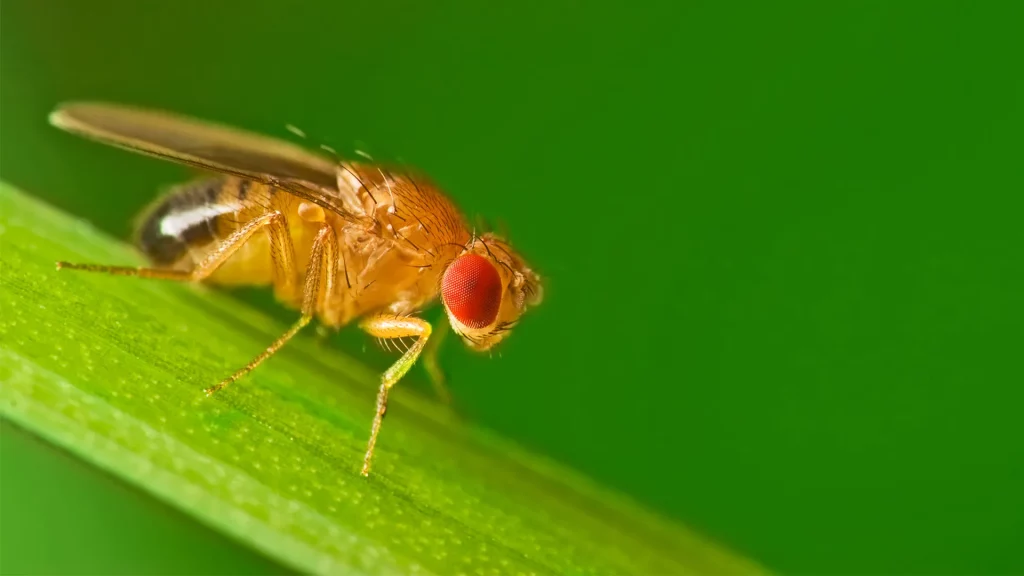Flies can typically live without food for about 2-4 days, but this can vary based on factors like species, age, and environmental conditions. They need sugars and proteins for energy and essential bodily functions.
Further, access to water is also important for their survival. In a home environment, they can last up to a month with food and water, but without food, they won’t survive for more than a few days. Managing their access to food and water is key in pest control and public health efforts.
Here, you will see the life cycle and the solution to get rid of the flies.
How Long Can A Fly Live Without Food: Factors To Consider

Fly Species: Different species of flies have varying abilities to survive without food. Some species are more resilient and can endure longer periods without nourishment, while others are more sensitive to food deprivation.
Environmental Conditions: The environmental conditions in which a fly is situated play a significant role in its ability to survive without food. Factors like temperature, humidity, and the availability of water can impact longevity without food.
Age of the Fly: The age of the fly also matters. Young flies generally have more energy reserves and can survive longer without food compared to older ones.
Extreme Cases: In exceptional circumstances, flies have been known to survive without food for longer periods. Some reports suggest that certain fly species can endure up to several weeks without eating, especially when environmental conditions are favorable.
Adaptations for Survival: Lastly, they have developed various adaptations to endure food scarcity, including reduced activity, lower metabolic rates, and energy conservation strategies. These adaptations help them conserve energy and prolong their survival in the absence of food.
Understanding the Simple Fly Life Cycle
Fly Eggs:
Female flies lay their eggs in groups, usually around 70 to 200 eggs at a time, and they can lay as many as 500 eggs in a short time. The number of eggs a female fly can lay depends on her size, which is influenced by the food she ate when she was a baby fly.
Further, These eggs are usually white and about 1.2 mm long. They are often found in dark, warm, and damp places to stay moist and safe. The time it takes for the eggs to hatch can vary, from 8 to 20 hours or even several days, depending on how warm and humid it is. The eggs need moisture to hatch, and the best temperature for hatching is between 25 and 30°C. If many flies lay their eggs close together, you can end up with a lot of baby flies.
Fly Larvae (Maggots):
Fly larvae, often called maggots, look like pale worms with a pointy end and tiny black hooks. These hooks help them stick to and eat things like animal remains, manure, and garbage where they were born. It has three phases, and the larvae grow to be about 7 to 12 millimeters in size before they become pupae. The time they spend as larvae depends on things like how warm and damp it is. In good conditions, it’s usually 3 to 7 days, but it can be as long as 55 days in not-so-good conditions.
Fly Pupae:
After being larvae, flies enter the pupal stage, which is crucial in their life cycle. During this time, flies don’t move or eat. They build a shell like a cocoon where they grow their wings, antennas, and legs. When they come out of this shell, they become full-grown adult flies.
Then, the pupal stage is known for the case that forms around them, changing from yellow to black as the pupa gets older. Unlike the long, skinny shape of larvae, pupae look like round, dark brown ovals with blunt ends. It takes them about 2 to 6 days to finish growing in warmer temperatures, but it can take 17 to 27 days in cooler conditions.
Besides, to break free from the pupal case, the emerging fly puffs up a sac on its head called the ptilinum to push its way out. Knowing about the pupal stage is vital for controlling fly populations because it’s a good time to use bug sprays and other ways to get rid of them.
Adult Flies:
The last part of a fly’s life cycle is when they become adults. They have their full wings, antennas, and legs. They are usually about 6 to 7 mm long and can live for 15 to 25 days, sometimes even up to two months if they are safe. But if they don’t find food, they can only live for about two to three days.
Also, they like sweet things, and they are active during the day and rest at night because they can’t see well in the dark. At night, they find safe places to hide, like on buildings, trees, shrubs, or tall grass. They like to lay their eggs near things like horse manure, human waste, cow manure, rotting plants, and kitchen waste. Just a few hours after becoming adults, they are ready to have babies and lay their eggs near food.
How do flies make babies, and what do they need to lay their eggs?
Flies make babies soon after they become adults. The boy flies do a little dance to impress the girl flies. This can take anywhere from 30 minutes to 2 hours. If the girl flies like the dance and are ready to have babies, they let the boy fly know.
Then, after the dance, the girl flies look for a warm, wet place with enough food to lay their eggs. They lay their eggs in groups of 75 to 200 and can do this a few times over a few days.
To make babies, the girl flies need to have the right food, especially protein. The grown-up flies have to eat before they can make babies. Making babies can take as little as two minutes or as long as 15 minutes. The time when they lay their eggs usually starts 4 to 20 days after they’ve danced and made babies.
What is the Lifespan of a fly?
Flies don’t live very long, typically around 15 to 25 days. But they experience time differently than we do, and they see things much faster than we do. So, when we try to swat them with a newspaper, it seems to happen in slow motion from their point of view. Flies can go from being an egg to a grown-up in just 15 to 30 days, although it can take longer in warm places with plenty of food.
| Fly Species | Lifespan | Reproduction |
| House Fly | 20-30 days | 5-6 egg batches, up to 3,000 eggs per female |
| Fruit Fly | 40-50 days | Up to 500 offspring per female |
| Horse Fly | 30-60 days | Eggs laid on grass in the fall, emerging in early June |
| Tsetse Fly | 30-120 days | Females live 1-4 months, males live 2-3 weeks |
| Gnat | 7-14 days | Short-lived, average lifespan of 7-14 days |
How can you effectively deal with a fly infestation in your home?
To get rid of flies, you should take some steps to stop them from coming in and to clean up if they’re already there. Flies can carry diseases and make your food dirty, so it’s important to deal with them.
Prevent Flies:
- Fix any broken window screens, so flies can’t get inside.
- Keep your place clean and don’t leave trash lying around.
- Make sure your sink drains are clean.
- If you already have lots of flies, it’s a good idea to call experts who can use special stuff to get rid of them.
Let the Pros Help:
It’s better to let trained experts handle things like chemical sprays to deal with flies. They can check your place to find where they might be laying their eggs, like in drains or small openings in your house. Once they figure it out, they can use treatments to get rid of them and make sure they don’t come back.
Furthermore, Preventing them is important, so you don’t have to deal with a lot of them. But if you already have too many, it’s best to get help from professionals to get rid of them and stop them from coming back.
How can you prevent flies from becoming a nuisance in your home?

To stop flies from coming into your place and causing health issues, you can do a few things:
- Clean your surfaces regularly.
- Store your food the right way.
- Fix any leaks.
- Don’t forget to take out the trash.
Further, It’s also a good idea to close all the windows, doors, and any holes in your house to keep flies away. If you’ve tried all of this and still have too many flies, you can call a local pest control service for help from the experts.
FAQ’s
How Long Do Flies Live in Your House?
Flies can live their entire lifespan in your house, up to 4 weeks, and sometimes longer. The average housefly lives 15-30 days. Preventing infestations through cleanliness and pest control is important.
Can flies overwinter in my house?
Yes, some fly species can overwinter indoors, extending their lifespan to several months.
What attracts flies to my house and how can I prevent them?
Flies are drawn to food, moisture, and open windows. To prevent them, maintain cleanliness, proper food storage, seal windows and doors, and manage trash.
Why do fly lifespans vary in different houses?
Fly lifespans indoors can vary due to the home’s conditions and environment, impacting how long they live.
When should I seek professional pest control for a fly issue in my house?
If fly problems persist despite preventive measures, consider contacting a local pest control service for assistance.
Final Words
To wrap up, the duration a fly can survive without food typically ranges from 2-4 days, depending on factors like species, age, and environmental conditions. Their preference for high-calorie foods, the need for specific nutrients like proteins for reproduction, and their ability to conserve energy during food scarcity are all vital aspects of their survival. Adequate hydration is also critical for their well-being.
Moreover, understanding these facts is not only fascinating from a biological perspective but also holds practical implications for pest control and public health. By disrupting flies’ access to food and water sources, you can effectively manage their populations and reduce the associated health risks. Whether for scientific curiosity or practical management, knowing how long flies can survive without food is an essential part of our understanding of these ubiquitous insects.











